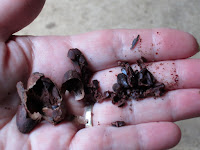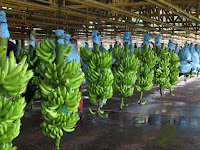 "Rain gear and good walking/hiking shoes are critical. In some areas, closed toe shoes will be mandatory!!" Toyota International Teacher Program, Costa Rica 2011, Travel Information
"Rain gear and good walking/hiking shoes are critical. In some areas, closed toe shoes will be mandatory!!" Toyota International Teacher Program, Costa Rica 2011, Travel Information
"You may just think I'm gilding the lily pad here. But as a tadpole I always wanted to be a dancer. But you know what they say, the first thing to go on a frog are his legs. " Kermit the Frog, The Muppet Show: Episode #1.1 with Juliete Prowse
Reason #6 Poison Dart Frogs
 The reason poison dart frogs make the list is that their skin is toxic and frogs are usually on the ground. It is number 6 because, unless you are an ant or other insect, you will likely experience only happiness upon encountering a poison dart frog. They tend to be heard more than seen.
Photo: Green black-spotted poison dart frog
The reason poison dart frogs make the list is that their skin is toxic and frogs are usually on the ground. It is number 6 because, unless you are an ant or other insect, you will likely experience only happiness upon encountering a poison dart frog. They tend to be heard more than seen.
Photo: Green black-spotted poison dart frog
Video: Bluejean or Strawberry Poison Dart Frog (Video credit: Kelly Foss)
"Snakes. Why'd it have to be snakes?" - Indiana Jones, Raiders of the Lost Ark
Reason # 5 Snakes
"Armadillo..." and with that a dozen teachers ran into the field to take a picture. Our EARTH University host shook his head urging the photographers to return to the concrete surface of the dining patio and strongly suggesting that we remain on the covered walkways at night. There are snakes in the tropical paradise of the rain forest. Not little garter snakes, but large and/or deadly poisonous snakes. Pit vipers and the dreaded Fer-de-Lance (Terciopelo in Spanish) are at home in the tangled forest understory and fields of Costa Rica. We occasionally saw snakes coiled on rocks or tree limbs catching the few solar rays piercing the low cloud ceiling. We had no firsthand encounters with the Fer-de-Lance, only secondhand tales from guides and hotel workers that begin "Oh, this morning..." or "Late last night..." Although snakes would be the most deadly encounter with bare feet, it was the least frequent and therefore is fifth on the list of six reasons to wear closed toe shoes.
On the left, hog nose pit viper warming up on a rock at Guayabo National Monument. On the right, an eyelash pit viper curls up on a tree limb at Arenal Hanging Bridges.
"I got killer buds / A power stem / Nasty pods..." Audrey II, Little Shop of Horrors
Reason #4 Poisonous Plants
The good news first. There is no poison ivy in Costa Rica. However, tropical plants have evolved toxins as a means of survival. Although not aimed specifically at humans, the toxins can have consequences ranging from an itchy rash to death.
The sap of the manzanillo tree is acidic and milky white causing temporary blindness on contact with the eyes. Smoke from burning manzanillo wood can irritate eyes, skin, and respiratory tract tissues. The thorns and bark can cause skin irritation. The sap is toxic to aquatic organisms. The apples are poisonous. The tree is easy to recognize because nothing grows on, in, or around it. The photo shows a group of teachers helping clear trees at Finca la Chiquita, a farm that hosted a homestay. The manzanillo tree is in the background on the left side of the photo behind the man in the red shirt. The tree was left standing. (Photo credit: Kelly Foss)
Even pretty flowers needed to be respected. Xanthosoma, dieffembachia, and alamanda all have caustic saps in their leaves and vines.
Stinging nettles spring up in fields and off the path. As the name implies, they are itchy and irritating, but otherwise harmless. Their seeds are hitchhikers and cling to wool socks. I picked seeds off my socks prior to packing.
 Clever plants appear poisonous even when they are nontoxic. The color red is usually the warning sign of a toxic plant. The young leaves of the cycad Ceratozamia are delicate and nontoxic. However, they are red. As the plant matures, the leaves develop toxicity and toughness. The mature leaves are green. Cycads were the food of the herbivorous dinosaurs. They are currently being studied at La Selva Biological Station because of their diversity and conservation issues related to plicate-leaved Zamia species.
Clever plants appear poisonous even when they are nontoxic. The color red is usually the warning sign of a toxic plant. The young leaves of the cycad Ceratozamia are delicate and nontoxic. However, they are red. As the plant matures, the leaves develop toxicity and toughness. The mature leaves are green. Cycads were the food of the herbivorous dinosaurs. They are currently being studied at La Selva Biological Station because of their diversity and conservation issues related to plicate-leaved Zamia species.
"A web would indicate an arachnoid presence." Dilbert McClintock, Arachnophobia
Reason #3 Spiders and Millipedes
 Anything that crawls underfoot, climbs, or spins a web should be respected, but not necessarily feared. A nip can cause a welt, swelling, or in the most sensitive individual an allergic reaction. Tarantula holes were spotted, but the spider was not seen. A wolf spider and golden orb spider were seen with their webs. Millipedes were observed. Because no one was actually bitten by an arachnid or millipede, they earn the number 3 spot as reasons to wear closed toe shoes.
Anything that crawls underfoot, climbs, or spins a web should be respected, but not necessarily feared. A nip can cause a welt, swelling, or in the most sensitive individual an allergic reaction. Tarantula holes were spotted, but the spider was not seen. A wolf spider and golden orb spider were seen with their webs. Millipedes were observed. Because no one was actually bitten by an arachnid or millipede, they earn the number 3 spot as reasons to wear closed toe shoes.


(Millipede and wolf spider: Gregory Regalado)
"None of the ants previously seen by man were more than an inch in length - most considerably under that size. But even the most minute of them have an instinct and talent for industry, social organization, and savagery that makes man look feeble by comparison." Dr. Harold Medford, Them!
Reason #2 Ants
When I first heard the warning about the Fer-de-Lance, I thought it was a warning against stepping into "fertile ants." (Say fur-tuh-lance aloud.) With queen ants that lay thousands of biting and stinging offspring each day, fertile ants is reason #2 to wear closed toe shoes.
An estimated 84 genera of ants live in Costa Rica. "Costa Rica Ants" is an entire section of AntWeb.org. The ants climb on trees, live in trees, build nests in the soil, and swarm across the forest floor.
 Leafcutter ants have highways that intersect trails and cross walkways. Compared to other species they are benign and indifferent to humans. These industrious little fellows actually inspire humans to be careful not to disrupt the 24/7 rush hour rhythm of their super highway infrastructure.
Leafcutter ants have highways that intersect trails and cross walkways. Compared to other species they are benign and indifferent to humans. These industrious little fellows actually inspire humans to be careful not to disrupt the 24/7 rush hour rhythm of their super highway infrastructure.  In contrast, bullet ants lie in wait on handrails and posts. Their acid injection causes a painful swelling that burns like a bullet wound. (photo credit: Gregory Regaldo)
In contrast, bullet ants lie in wait on handrails and posts. Their acid injection causes a painful swelling that burns like a bullet wound. (photo credit: Gregory Regaldo)Army ants swarm in fronts. The soldiers have impressive machete-like mandible tips that decapitate small prey. Those same mandibles dig in and hold onto human flesh as they inject acid. Run and stomp your boots is the best advice anyone can receive regarding an encounter with a moving front of army ants.
The phrase "ants in your pants" takes on a whole new meaning for anyone who sits down on the ground, a log, or a rock or fails to tuck pant legs into boot tops. Cecropia and acacia ants will defend their home trees with a vengeance. These little red ants leave small welts along the legs and arms of those who brush by the plants on which they live.
Ants marched through hotel rooms and made themselves at home in suitcases and beds. A teacher let the front desk know the room had ants and was told, "Yes. That is normal." Fortunately, these ants didn't seem to be bothered by humans in their habitat.
One group of intrepid pioneers set up camp in my laptop keyboard. In the absence of a taxonomic guide and magnifying glass (they were tiny), I dubbed them MacBook ants. I feared that my laptop would be confiscated by U.S. Customs agricultural control . Getting rid of the ants before returning home redefined debugging the computer. On the advice of our school technology teacher, I chilled the laptop. The ants did not like cool conditions and either evacuated or died. My MacBook needs a spa day at the Apple Store. It had a stressful adventure in the rain forest. (More on technology challenges in a later posting.)
Because of the frequency of ant encounters, this is the number 2 reason for wearing closed toe shoes, although teachers who felt like ant-bait might argue it as the number 1 reason.
"One day it started raining, and it didn't quit for four months. We've been through every kind of rain there is. Little bitty stinging rain...and big old fat rain. Rain that flew in sideways. And sometimes rain even seemed to come straight up from underneath. Shoot, it even rained at night." Forrest Gump, Forrest Gump
Reason #1 Mud and Rocks
 The number one reason for wearing closed toe shoes is rain. Rain turns soil into mud and makes rocks slippery. I am the bog huntress. Even if the bog defies the law of gravity and lies uphill, I will find it and step into it. The sneakers I wore the first day of walking in mud never came clean and never dried in the humidity of the rainy season. I left the sneakers in Costa Rica with a charitable organization that repairs clothing for donation to the abandoned elderly. My hiking boots survived, but getting the mud out of the treads and laces took some doing. It was worth the effort. The boots were inspected and made it through U.S. Customs. (On a farm, mud may be more than just soil.)
The number one reason for wearing closed toe shoes is rain. Rain turns soil into mud and makes rocks slippery. I am the bog huntress. Even if the bog defies the law of gravity and lies uphill, I will find it and step into it. The sneakers I wore the first day of walking in mud never came clean and never dried in the humidity of the rainy season. I left the sneakers in Costa Rica with a charitable organization that repairs clothing for donation to the abandoned elderly. My hiking boots survived, but getting the mud out of the treads and laces took some doing. It was worth the effort. The boots were inspected and made it through U.S. Customs. (On a farm, mud may be more than just soil.)
Think About It
Why are species that produce toxins successful in the struggle for survival?
How does a species benefit from mimicry?

















































